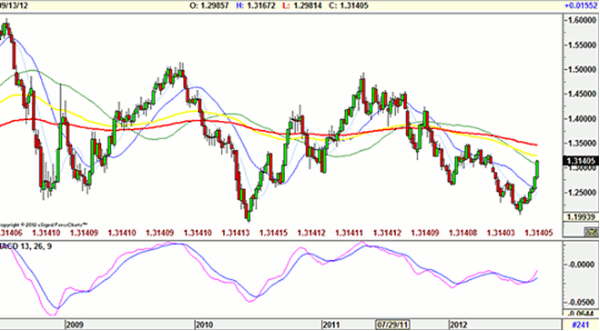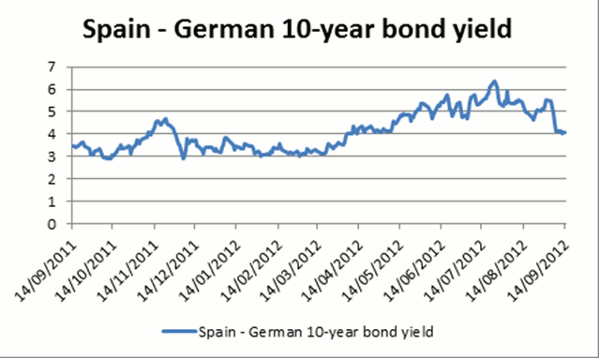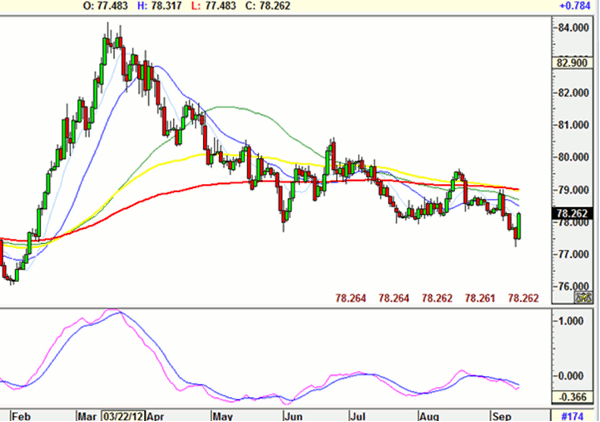Kathleen Brooks highlights the events and indicators likely to shape the forex markets this week.
There was some thrilling action in financial markets last week. In the last ten days, EUR/USD is up 600 points, the S&P 500 is comfortably above 1,450, and Brent crude oil is testing $117 per barrel (and may test $120 in the coming days).
The chief drivers have been stimulative monetary policies from the Federal Reserve in the US and the European Central Bank in the Eurozone. Both banks have pledged “unlimited” support to sort out their respective problems—and for the first time since the financial crisis broke out in 2008, the Fed and the ECB have said they won’t stop until the problems are solved. This is aggressive action from the world’s most important central banks, and the markets like it.
Looking at the Fed first, its QE3 program will purchase $40 billion per month of mortgage-backed securities until the unemployment rate drops to a level acceptable to the Fed. The Fed did not state what this level was, but we believe it could be somewhere south of 7%.
On the surfac0,e this looks like the Fed has left itself open to an unlimited liability on its balance sheet, which is dollar-negative. But if the economy picks up and the unemployment rate starts to fall, then the Fed may halt QE3. The Fed is trying to do two things with QE3:
- anchor its latest round of unconventional policy to the performance of the economy
- reduce long-term interest rates even further
The Fed also pledged to keep interest rates between 0 and 0.25% until 2015, and is extending its Operation Twist program.
QE3's Impact on the Dollar
What has been interesting is that US Treasury yields have actually risen since the Fed action.
The Fed is hoping that its latest round of policy stimulus will mean that more people move out of Treasuries and into riskier assets like real estate and stocks, in an attempt to generate employment and boost the economy. Thus, going forward we may see Treasury yields continue to rise as people sell their holdings of government debt.
But if Treasury yields are rising, why doesn’t the dollar strengthen? It is all because of supply and demand. The Fed is buying up mortgage-backed securities using freshly printed money, this should—in theory—boost the size of the money supply, which is dollar-negative.
The market doesn’t wait until it gets concrete data about the money supply to make its move; instead, it reacts to the potential impact of QE3, which is why we have seen the dollar decline on a broad basis since July. But traders want to know what this means for the long-term outlook for the dollar, and whether the decline can be expected to continue.
Back in 2010, the dollar fell after the immediate announcement of QE2 from the Fed, before rallying again over the next four weeks. After reaching 1.40 in the build-up to QE2, the euro then fell below 1.30 the weeks following the announcement, before rallying back above 1.45 from January to June 2011.
Post the QE3 announcement, the dollar is looking extremely oversold, so a pullback in risky assets in coming days would not be unusual. However, we believe that the sell-off, especially in EUR/USD, could be fairly shallow due to the ECB action to reduce credit risk in the currency bloc (see more below). We believe this pair could trade in a 1.28 to 1.35 range until the end of the year.
Next: Reacting after big policy announcements
|pagebreak|After big policy announcements like the ones we have seen, I like to look at the long-term charts to get a grip on where currencies may go next. On the weekly EUR/USD chart, there is a key resistance level around 1.35—the 200-week moving average. The weekly MACD momentum indicator is pointing higher, suggesting there could be further upside to come. However, the 1.35 level is going to be a tough hurdle for the bulls to clear in the medium term.
The ECB as the Svengali of the Markets
There were some important developments in the Eurozone last week. First, the German Constitutional Court ruled that the ESM long-term rescue fund was legal. Second, the Dutch public voted in a pro-euro Liberal party at its general election last Wednesday.
These are key developments, as they concern two major creditor countries in the currency bloc, and highlight their commitment to the euro project.
Add these events to the ECB’s OMT program announced at its meeting at the start of September, and there has been a significant reduction in the tail risk of either the Eurozone falling apart or the fear of Spain applying for a sovereign bailout—as the ECB‘s bond-buying program won’t actually get triggered until Spain or Italy apply for either a bailout or a precautionary credit line.
Some have argued that the German Court’s decision that Berlin could not give more than €190 billion to the ESM leaves the bailout fund without enough firepower to bail out Spain and Italy. However, the ECB’s OMT program makes the size of the ESM fairly irrelevant.
The ECB’s bond-buying program makes the prospect of a country actually needing to tap the ESM fairly minimal. If Spain applies for a bailout program with all of the conditions attached, then the ECB can start buying the bonds of that country, which should mean they can continue to tap the capital markets for funds because the ECB acts as a reliable buyer in the secondary markets.
This doesn’t address competitive issues faced by some countries in the currency bloc, and it doesn’t reduce any of their debt burdens, but it could help boost their economic growth. There is a negative correlation between falling bond yields and rising consumer and business confidence, which should feed into stronger growth in the long term.
The ECB is most likely hoping that growth should bottom sometime around the end of the year, and if Spanish bond yields continue to fall then the Bank may have helped to ease credit conditions in the currency bloc without buying any sovereign debt. The ECB is acting as a Svengali in Europe’s peripheral bond market.
Next: This weeks's initial PMI readings
|pagebreak|This week, we get initial PMI readings for the currency bloc for September. They are expected to pick up slightly, but remain mired in contraction territory.
The markets will be looking for some improvement in the outlook for Germany; it releases its ZEW survey on Tuesday. This survey is expected to pick up after sharp declines for most of this year, which may be deemed encouraging by the markets and could help to extend the recent rally in the euro and the Dax.
The Yen Falls Sharply Post-Fed
Compared with the dollar’s performance against the other major currencies, it strengthened against the yen after the Fed’s QE3 announcement. This is due to a couple of things:
- the threat of intervention risk from the Japanese authorities, and the prospect of the Bank of Japan significantly boosting the size of its Asset Purchase Program when it meets on Wednesday
- the rise in Treasury yields tends to be positive for USD/JPY
This pair broke through 78.00 on Friday, which may placate the Japanese to some extent. But we believe they want to see a move back above 80.00 in this pair.
So what does the move in USD/JPY tell us about the prospect of continued dollar weakness in other crosses? At this stage, it is hard to tell.
It is natural for USD/JPY to react to a move in Treasury yields. Also, as market and sovereign risk levels have dropped, the yen tends to get sold off. Thus, the move higher in USD/JPY is perfectly normal at this stage. However, if we see continued strength in $JPY then this could start to beef up the greenback against other currencies and we could see a limit to dollar weakness, so watch out.
But in the next few days the trajectory for this pair will be dependent on the outcome of the BOJ meeting. The finance minister said on Friday that monetary policy could be shaped by outside factors (read the FOMC rate decision), so we could see an extension in the Asset Purchase Program to the tune of 10 trillion yen.
This may be enough to get this pair to 80.00 in the medium term, especially if the BOJ follows the Fed’s lead and uses the term “unlimited” when it comes to future asset purchases.
Kathleen Brooks can be found at Forex.com.
























